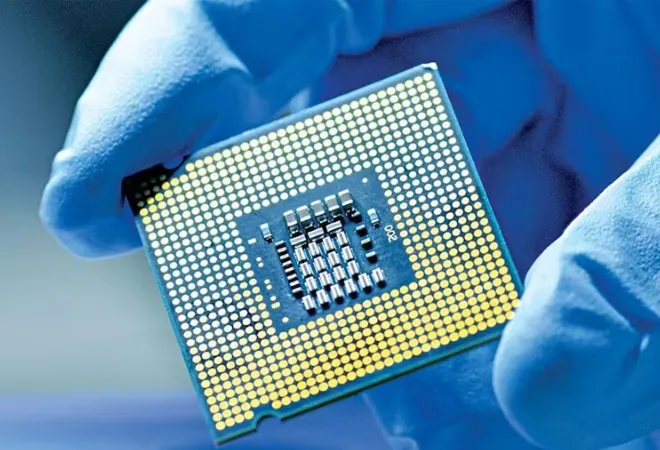
Prime Minister Narendra Modi arrived in the United States (US) this week with a packed schedule of interactions, including a state dinner and an address to the US Congress. Among the headline deliverables is an agreement on semiconductor supply chains, building on a Memorandum of Understanding (MoU) on Semiconductor Supply Chain and Innovation Partnership signed in March 2023.
With the focus now firmly on India’s emergence as a semiconductor hub, it is pertinent to look back on the history of India’s semiconductor policy efforts, what worked and what did not, and how this can inform policymaking now.
From scientific temper to a fledgling semiconductor industry
At the time of its independence in 1947, India had undergone nearly two centuries of “deindustrialisation” under the British Raj. While the depth and breadth of this phenomenon is contested, what remains true is that India had fallen behind in the two industrial revolutions that had passed by it, and would need to catch up to developed economies. India’s early post-Independence technology policies are in many ways reminiscent of its current focus on Aatmanirbhar Bharat. According to some accounts, this early focus was driven largely by former Prime Minister Jawaharlal Nehru’s emphasis on ‘scientific temper’, or an understanding of the technologies being used, rather than technology being deployed for its own sake. Indeed, Nehru’s early encounters with American industrialists elicited the same response as India’s modern industrial policies. As then-US ambassador Stephen Grady said, “Indian friends seemed to think American know-how can be shipped to them in sealed cases laid down at Indian ports”.
The government relaxed some licensing requirements and lifted import duties on computers and other electronic equipment. Gandhi also invited investments into electronics, telecommunications, and energy, among others, on several trips to Europe, Japan, and the US.
In the 1960s, a handful of Indian companies were producing germanium semiconductors, and during this period, Fairchild Semiconductors, a pioneer in integrated circuit (IC) technology, considered India as a possible location for its first Asia unit. In this period, Bharat Electronics Ltd. (BEL), a public sector undertaking (PSU) under the Ministry of Defence (MoD), acquired germanium and silicon technology for producing semiconductor devices. BEL, along with Hindustan Aeronautics Ltd. (HAL), another PSU under the MoD, remains a major player in the semiconductor space in India but caters only to the defence sector.
While this early progress was slow, the semiconductor industry in India picked up pace in the 1980s, spurred by a series of policies under the Rajiv Gandhi government. The government relaxed some licensing requirements and lifted import duties on computers and other electronic equipment. Gandhi also invited investments into electronics, telecommunications, and energy, among others, on several trips to Europe, Japan, and the US.
In 1984, the Indian government took a significant step by establishing Semiconductor Complex Ltd. (SCL) as a public sector undertaking. This venture was made possible through licensing agreements with Hitachi, AMI, and Rockwell. Simultaneously, the government opened bidding for the establishment of a National Silicon Facility, which garnered substantial interest from companies in the United States and East Germany at that time. Eventually, the newly-formed Indian company Metkem Silicon Ltd., with support from BEL (Bharat Electronics Limited), established its polysilicon facilities in Mettur, Tamil Nadu.
According to a 1989 paper analysing India’s semiconductor push, “The Indian semiconductor industry has carved out a unique worldwide niche. While cutting-edge semiconductor chips are imported from US companies like Intel, Motorola, and Rockwell for use in Indian computers, less technologically advanced chips are produced in India. India exports older-generation semiconductor chips, which have been phased out by semiconductor producers in most other countries.”
The government opened bidding for the establishment of a National Silicon Facility, which garnered substantial interest from companies in the United States and East Germany at that time.
At the end of the 1980s, India was just two years behind the latest semiconductor manufacturing technologies.
The slow death of India’s edge
India lost this manufacturing lead in the decades since the 1990s. In 1989, the SCL complex in Chandigarh faced a devastating fire, causing significant damage. Although efforts were made to revive the complex, it would only produce a limited number of chips for India's Space Research Organisation (ISRO). The subsequent years saw the implementation of economic liberalisation policies starting in 1991, which led to an influx of cheap semiconductor imports. Finally, the semiconductor manufacturing ecosystem in India faced challenges due to the lack of promised government subsidies, particularly in the area of electricity.
In 2007, the government at that time announced the development of India's first Semiconductor Policy. The objective was to attract INR 24,000 crore of investment over three years, along with the establishment of three fabrication units. During this period, both AMD and Intel were considering the possibility of setting up fabrication units in India. SemIndia, a consortium of Indian technologists, signed a licensing agreement with AMD Inc to use the latter’s technology to set up a water fab. Intel, which had set up India operations in 1988, announced it would invest US$ 1 billion in India, as well as a possible fab facility. Both failed to take root, however, due to a variety of factors, including the delay in the passage of the Semiconductor Policy as well as the policy’s strict minimum investment requirements. AMD’s decision to split off its fabrication units into a separate company, which became GlobalFoundries, was also a factor, as were fundraising issues and production delays.
SemIndia, a consortium of Indian technologists, signed a licensing agreement with AMD Inc to use the latter’s technology to set up a water fab.
The final chapter in India’s semiconductor policy history came in 2013-14, when the government tried to revive its semiconductor push, issuing Letters of Intent (LOIs) to two consortiums—Hindustan Semiconductor Manufacturing Corporation (ST Microelectronics and Silterra Malaysia Sdn. Bhd.) and Jaiprakash Associates Ltd. (IBM, Tower Semiconductor Ltd). The latter withdrew its proposal in 2016, citing capital outlay issues. The government cancelled the permit to HSMC in 2019, after years of paperwork delays on HSMC’s part.
Lessons learnt?
The government's efforts to relax regulations, attract investors, and promote domestic businesses played a crucial role in the early successes during the 1970s and 80s. However, India's bureaucratic system eventually became an impediment, characterised by a lack of coordination between ministries and government agencies, sluggish policy implementation, delayed grant announcements, and inadequate supporting infrastructure. As a result, the country experienced a significant lag. Semiconductor companies function on different timelines than governments do: The long-term supply chain diversification benefits of setting up facilities in new countries can only go so far, and the longer the delays in incentive packages, land allocation, construction, etc, the higher the opportunity cost for these companies. The TSMC plant in Arizona, US is, for instance, already contending with construction delays, and per experts at a Taiwan-India Dialogue in October last year, it is a safer bet for semiconductor companies to set up plants in existing hubs, with familiar suppliers.
The compounded incentives offered by the Indian government, state governments, and partnerships forged through arrangements like the US-India semiconductor MoU, would sweeten the deal as well.
The history of India’s semiconductor policies then provides a key lesson: Government interventions need to lightly tread the balance between strategic and well-thought-out on the one hand, and timely, in keeping with industry timelines on the other. India is no doubt attractive for semiconductor firms, not least because it is a hub for chip design. The compounded incentives offered by the Indian government, state governments, and partnerships forged through arrangements like the US-India semiconductor MoU, would sweeten the deal as well. Yet speed, provision, and maintenance of basic infrastructure, smooth approvals and licenses, would be critical in helping realise the Indian government’s vision to move India up the global semiconductor value chain.
Trisha Ray is a Deputy Director with the Centre for Security, Strategy and Technology at the Observer Research Foundation
<1> This piece is adapted from a section of the author’s co-written paper, Cutting-Edge Technologies in Developing Economies: The Case of India’s Semiconductor Industry, Stanford University (May 2023)
The views expressed above belong to the author(s). ORF research and analyses now available on Telegram! Click here to access our curated content — blogs, longforms and interviews.




 PREV
PREV


